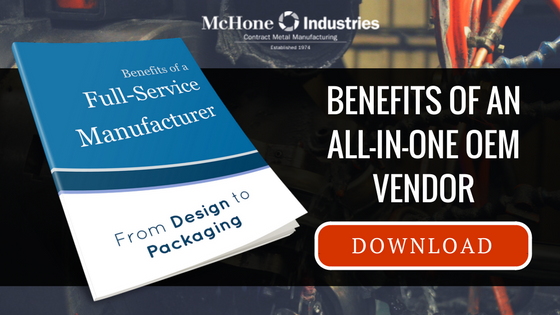.jpg?width=568&name=laser%20cutting%20(vs%20plasma%20cutting).jpg)
Many engineers and their customers have asked this simple question: Laser cutting or plasma cutting?
Deciding if sheet metal laser cutting is right for you can be complicated. First let’s review the basics of each.
How Cutting Methods Work
Lasers
Laser cutting, created in the 1960s, is a thermal process using a computer-directed focused beam of light -- along with oxygen, nitrogen, and compressed air -- to burn up, vaporize, or blow away the material in question. Exciting stuff.
Fun fact: The term “laser” originally was an acronym for “light amplification by stimulated emission of radiation.”
Plasma
Plasma cutting was developed in the 1950s to deal with metals that could not be flame cut. Here's how it works:
- Inert gas is blown out of a nozzle
- An electrical arc is passed through the gas
- The gas changes to plasma, an electrically conductive ionized gas.
The resulting plasma is hot enough to melt metal, which is then blown away from the cut.
P.S. It’s pretty cool to watch.
Laser vs. Plasma: Accuracy and Quality in Sheet Metal Cutting
High-definition plasma cutting machines are directly comparable to laser cutters in terms of accuracy and quality of the cut (as opposed to plain old air/plasma systems with CNC tables).
So let’s compare laser cutting to high-def class plasma systems. … You’re interested in top-notch professional quality, after all.
Because of laser cutting’s accuracy, this process is ideal for sheet metals that require tight tolerance specifications or precise cuts. This includes when a project calls for a small hole diameter in relation to the thickness of the metal.
Sheet metal laser cutting is superior in edge quality, as it yields a very square cut. However, on thicker mild steel or on stainless steel it can leave dross and generate pierce spatter.
Lasers can also cause some heat distortion, especially on a thicker plate. But if you’re working with a typical sheet metal size (under 1/4-inch thickness), this may not be an issue.
Plasma cutting will always result in some edge bevel angle and often causes dross. It also generates much more pierce spatter than laser, due to the larger kerf width.
This certainly doesn’t mean plasma cutting is useless on sheet metal. Plasma cutting is just fine for sheets with simple shapes and without intricate notching or many cutouts.
Uses of Laser Cutting vs. Plasma
Plasma use is limited to cutting, cutting, and more cutting. Laser systems can cut, engrave, and weld sheet metal.
But when it comes to cutting, laser is best limited to thin- and medium-thickness materials. Again, there’s a good chance the sheet metal you’re looking is thin, in which case laser is a viable option. Meanwhile, the plasma method may be more appropriate for cutting flat sheets of greater thickness.
Another benefit of plasma cutting is that it can work wonders with highly reflective metals on which lasers can’t be used.
Which Method Is Right for You?
Cutting methods should be evaluated on a case-by-case basis. Each project is unique -- no process is a cure-all for every application. Remember:
- Both offer high-quality and accurate cuts
- Laser cutting is best for: tight tolerances, detailed cuts, small cuts, thinner material
- Plasma cutting is best for: simple cuts, thicker materials, highly reflective materials
- Both can leave dross and pierce spatter, though plasma more so


